fuel YAMAHA PW50 2022 Owners Manual
[x] Cancel search | Manufacturer: YAMAHA, Model Year: 2022, Model line: PW50, Model: YAMAHA PW50 2022Pages: 82, PDF Size: 1.87 MB
Page 8 of 82

Table of contents
Location of important la bels ........... 1-1
Safety information ............................ 2-1
Description ....................................... 3-1
Left view ......................................... 3-1
Right view ....................................... 3-2
Controls and instruments ............... 3-3
Instrument an d control functions ... 4-1
Handlebar switch............................ 4-1
Speed limiter and power reduction
plate ............................................ 4-1
Front brake lever ............................ 4-2
Rear brake lever ............................. 4-3
Fuel tank cap .................................. 4-3
Fuel ................................................. 4-4
Fuel tank breather hose.................. 4-5
2-stroke engine oil .......................... 4-6
Fuel cock ........................................ 4-6
Starter (choke) lever ...................... 4-7
Kickstarter ...................................... 4-7
Seat ................................................ 4-8
Cable lock (for Europe) ................... 4-9
For your safety – pre-operation
checks ............................................... 5-1
Operation an d important ri din g
points ................................................ 6-1
Starting and warming up a cold engine ......................................... 6-1
Starting a warm engine .................. 6-2
Starting off ...................................... 6-2
Acceleration and deceleration ........ 6-3
Braking ........................................... 6-3
Engine break-in .............................. 6-4
Parking ........................................... 6-4
Perio dic maintenance an d
a d justment ........................................ 7-1
Owner’s tool kit .............................. 7-2
Periodic maintenance chart for the emission control system ............. 7-3
General maintenance and
lubrication chart .......................... 7-4 Checking the spark plug ................. 7-6
Removing the power reduction
plate ............................................. 7-7
Transmission oil .............................. 7-8
Middle and final gear cases .......... 7-10
Cleaning the air filter element ....... 7-10
Cleaning the spark arrester ........... 7-11
Adjusting the carburetor ............... 7-12
Adjusting the engine idling speed ......................................... 7-13
Checking the throttle grip free
play ............................................ 7-14
Tires .............................................. 7-14
Panel wheels ................................. 7-16
Adjusting the front and rear brake lever free play ............................ 7-17
Checking the front and rear brake
shoes ......................................... 7-18
Checking and lubricating the cables ........................................ 7-19
Checking and lubricating the throttle grip and cable ............... 7-19
Adjusting the Autolube pump ....... 7-20
Lubricating the front and rear
brake levers ............................... 7-20
Checking and lubricating the
centerstand ................................ 7-21
Checking the front fork ................. 7-21
Checking the steering ................... 7-22
Checking the wheel bearings ........ 7-22
Front wheel ................................... 7-23
Rear wheel .................................... 7-24
Troubleshooting ............................ 7-27
Troubleshooting chart ................... 7-28
Motorcycle care an d stora ge .......... 8-1
Matte color caution ......................... 8-1
Care................................................. 8-1
Storage............................................ 8-3
Specifications ................................... 9-1
Consumer information ................... 10-1
Identification numbers .................. 10-1 Reporting safety defects (For
CA NADA
c
ustomers) ................. 10-3
U2SA88E0.book Page 1 Tuesday, May 11, 2021 3:44 PM
Page 22 of 82

Safety information
2-4
2Aftermarket Parts, Accessories, an
d
Mo difications
While you may find aftermarket prod-
ucts similar in design and quality to
genuine Yamaha accessories, recog-
nize that some aftermarket accesso-
ries or modifications are not suitable
because of potential safety hazards to
you or others. Installing aftermarket
products or having other modifications
performed to your vehicle that change
any of the vehicle’s design or operation
characteristics can put you and others
at greater risk of serious injury or
death. You are responsible for injuries
related to changes in the vehicle.
Keep the following guidelines in mind,
as well as those provided under “Load-
ing” when mounting accessories. Never install accessories that
would impair the performance of
your motorcycle. Carefully inspect
the accessory before using it to
make sure that it does not in any
way reduce ground clearance or
cornering clearance, limit suspen-
sion travel, steering travel or con-
trol operation.
• Accessories fitted to the han- dlebar or the front fork area can
create instability due to improp-
er weight distribution. If acces-
sories are added to the
handlebar or front fork area,
they must be as lightweight as
possible and should be kept to
a minimum.
• Bulky or large accessories may seriously affect the stability of
the motorcycle. Wind may at- tempt to lift the motorcycle, or
the motorcycle may become
unstable in cross winds.
• Certain accessories can dis- place the operator from his or
her normal riding position. This
improper position limits the
freedom of movement of the
operator and may limit control
ability, therefore, such accesso-
ries are not recommended.
Use caution when adding electri-
cal accessories. If electrical ac-
cessories exceed the capacity of
the motorcycle’s electrical sys-
tem, an electric failure could re-
sult, which could cause a
dangerous loss of lights or engine
power.
Aftermarket Tires an d Rims
The tires and rims that came with your
motorcycle were designed to match
the performance capabilities and to
provide the best combination of han-
dling, braking, and comfort. Other
tires, rims, sizes, and combinations
may not be appropriate. Refer to page
7-14 for tire specifications and more in-
formation on replacing your tires.
Transportin g the Motorcycle
Be sure to observe following instruc-
tions before transporting the motorcy-
cle in another vehicle. Remove all loose items from the
motorcycle.
Check that the fuel cock is in the
“S” (stop) position and that there
are no fuel leaks.
U2SA88E0.book Page 4 Tuesday, May 11, 2021 3:44 PM
Page 24 of 82

Description
3-1
3
EAU63371
Left view
1234
56
1. Spark plug (page 7-6)
2. Fuel cock (page 4-6)
3. Throttle stop screw (page 7-13)
4. Air filter element (page 7-10)
5. Kickstarter (page 4-7)
6. Centerstand (page 7-21)
U2SA88E0.book Page 1 Tuesday, May 11, 2021 3:44 PM
Page 25 of 82
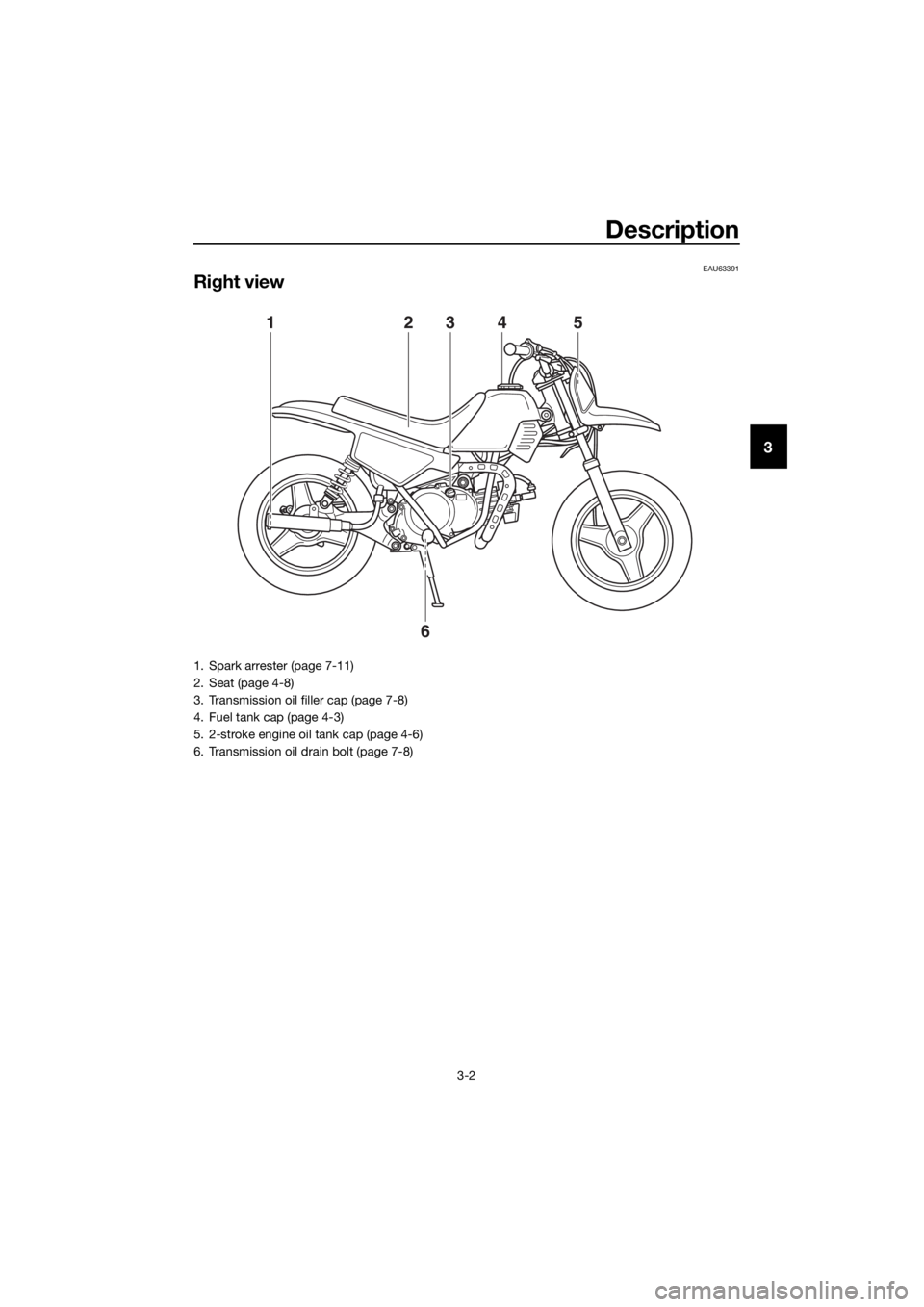
Description
3-2
3
EAU63391
Right view
12345
6
1. Spark arrester (page 7-11)
2. Seat (page 4-8)
3. Transmission oil filler cap (page 7-8)
4. Fuel tank cap (page 4-3)
5. 2-stroke engine oil tank cap (page 4-6)
6. Transmission oil drain bolt (page 7-8)
U2SA88E0.book Page 2 Tuesday, May 11, 2021 3:44 PM
Page 29 of 82
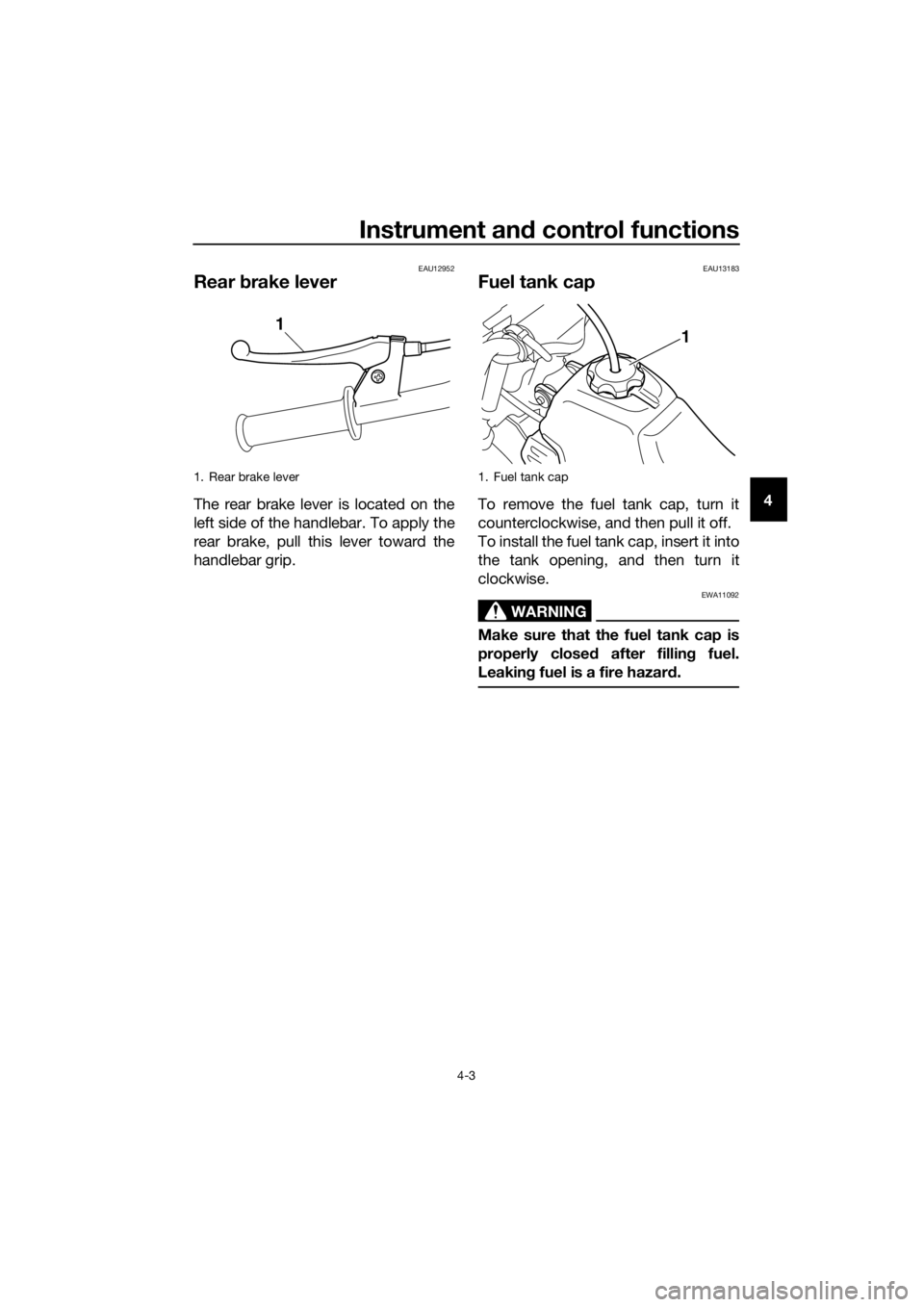
Instrument and control functions
4-3
4
EAU12952
Rear brake lever
The rear brake lever is located on the
left side of the handlebar. To apply the
rear brake, pull this lever toward the
handlebar grip.
EAU13183
Fuel tank cap
To remove the fuel tank cap, turn it
counterclockwise, and then pull it off.
To install the fuel tank cap, insert it into
the tank opening, and then turn it
clockwise.
WARNING
EWA11092
Make sure that the fuel tank cap is
properly close d after fillin g fuel.
Leakin g fuel is a fire hazar d.
1. Rear brake lever
1
1. Fuel tank cap
1
U2SA88E0.book Page 3 Tuesday, May 11, 2021 3:44 PM
Page 30 of 82
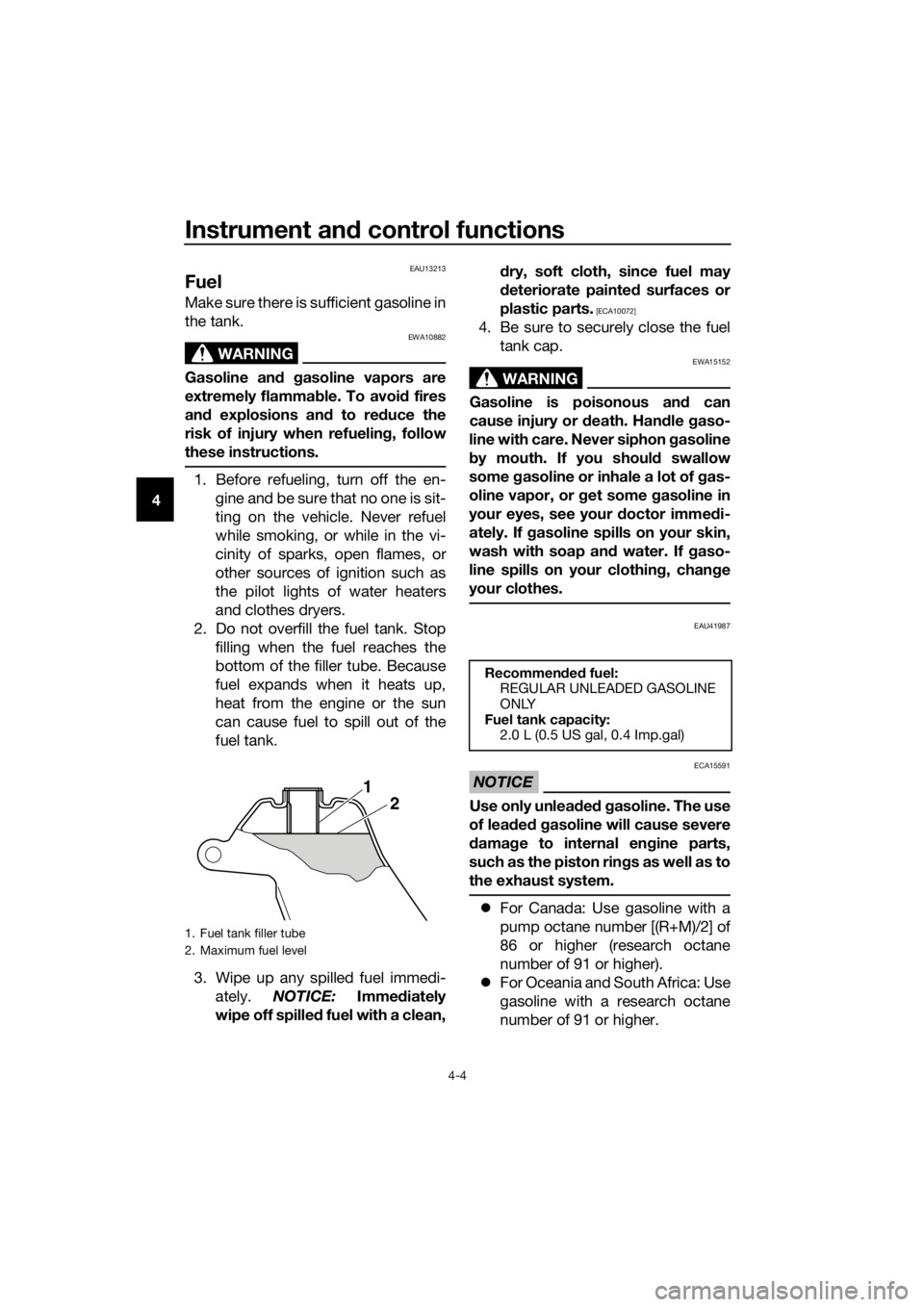
Instrument and control functions
4-4
4
EAU13213
Fuel
Make sure there is sufficient gasoline in
the tank.
WARNING
EWA10882
Gasoline an d g asoline vapors are
extremely flamma ble. To avoi d fires
an d explosions an d to re duce the
risk of injury when refuelin g, follow
these instructions.
1. Before refueling, turn off the en- gine and be sure that no one is sit-
ting on the vehicle. Never refuel
while smoking, or while in the vi-
cinity of sparks, open flames, or
other sources of ignition such as
the pilot lights of water heaters
and clothes dryers.
2. Do not overfill the fuel tank. Stop filling when the fuel reaches the
bottom of the filler tube. Because
fuel expands when it heats up,
heat from the engine or the sun
can cause fuel to spill out of the
fuel tank.
3. Wipe up any spilled fuel immedi- ately. NOTICE: Immediately
wipe off spille d fuel with a clean, d
ry, soft cloth, since fuel may
d eteriorate painte d surfaces or
plastic parts.
[ECA10072]
4. Be sure to securely close the fuel tank cap.
WARNING
EWA15152
Gasoline is poisonous an d can
cause injury or death. Han dle gaso-
line with care. Never siphon gasoline
b y mouth. If you shoul d swallow
some gasoline or inhale a lot of gas-
oline vapor, or get some gasoline in
your eyes, see your doctor imme di-
ately. If gasoline spills on your skin,
wash with soap an d water. If gaso-
line spills on your clothin g, chan ge
your clothes.
EAU41987
NOTICE
ECA15591
Use only unlea ded g asoline. The use
of lead ed g asoline will cause severe
d amag e to internal en gine parts,
such as the piston rin gs as well as to
the exhaust system.
For Canada: Use gasoline with a
pump octane number [(R+M)/2] of
86 or higher (research octane
number of 91 or higher).
For Oceania and South Africa: Use
gasoline with a research octane
number of 91 or higher.
1. Fuel tank filler tube
2. Maximum fuel level
2
1
Recommen
ded fuel:
REGULAR UNLEADED GASOLINE
ONLY
Fuel tank capacity: 2.0 L (0.5 US gal, 0.4 Imp.gal)
U2SA88E0.book Page 4 Tuesday, May 11, 2021 3:44 PM
Page 31 of 82
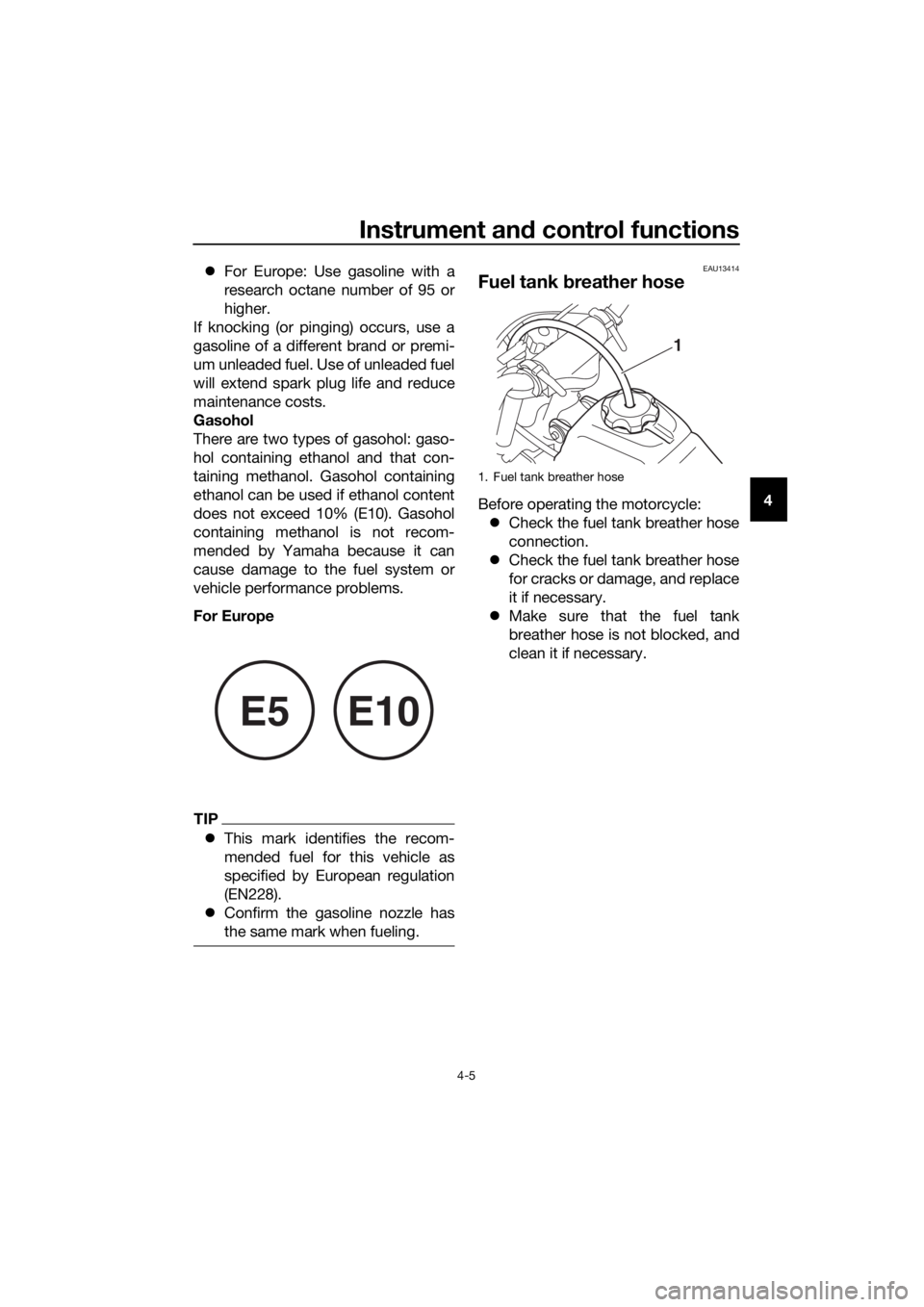
Instrument and control functions
4-5
4
For Europe: Use gasoline with a
research octane number of 95 or
higher.
If knocking (or pinging) occurs, use a
gasoline of a different brand or premi-
um unleaded fuel. Use of unleaded fuel
will extend spark plug life and reduce
maintenance costs.
Gasohol
There are two types of gasohol: gaso-
hol containing ethanol and that con-
taining methanol. Gasohol containing
ethanol can be used if ethanol content
does not exceed 10% (E10). Gasohol
containing methanol is not recom-
mended by Yamaha because it can
cause damage to the fuel system or
vehicle performance problems.
For Europe
TIP
This mark identifies the recom-
mended fuel for this vehicle as
specified by European regulation
(EN228).
Confirm the gasoline nozzle has
the same mark when fueling.
EAU13414
Fuel tank breather hose
Before operating the motorcycle:
Check the fuel tank breather hose
connection.
Check the fuel tank breather hose
for cracks or damage, and replace
it if necessary.
Make sure that the fuel tank
breather hose is not blocked, and
clean it if necessary.
E5E10
1. Fuel tank breather hose
1
U2SA88E0.book Page 5 Tuesday, May 11, 2021 3:44 PM
Page 32 of 82
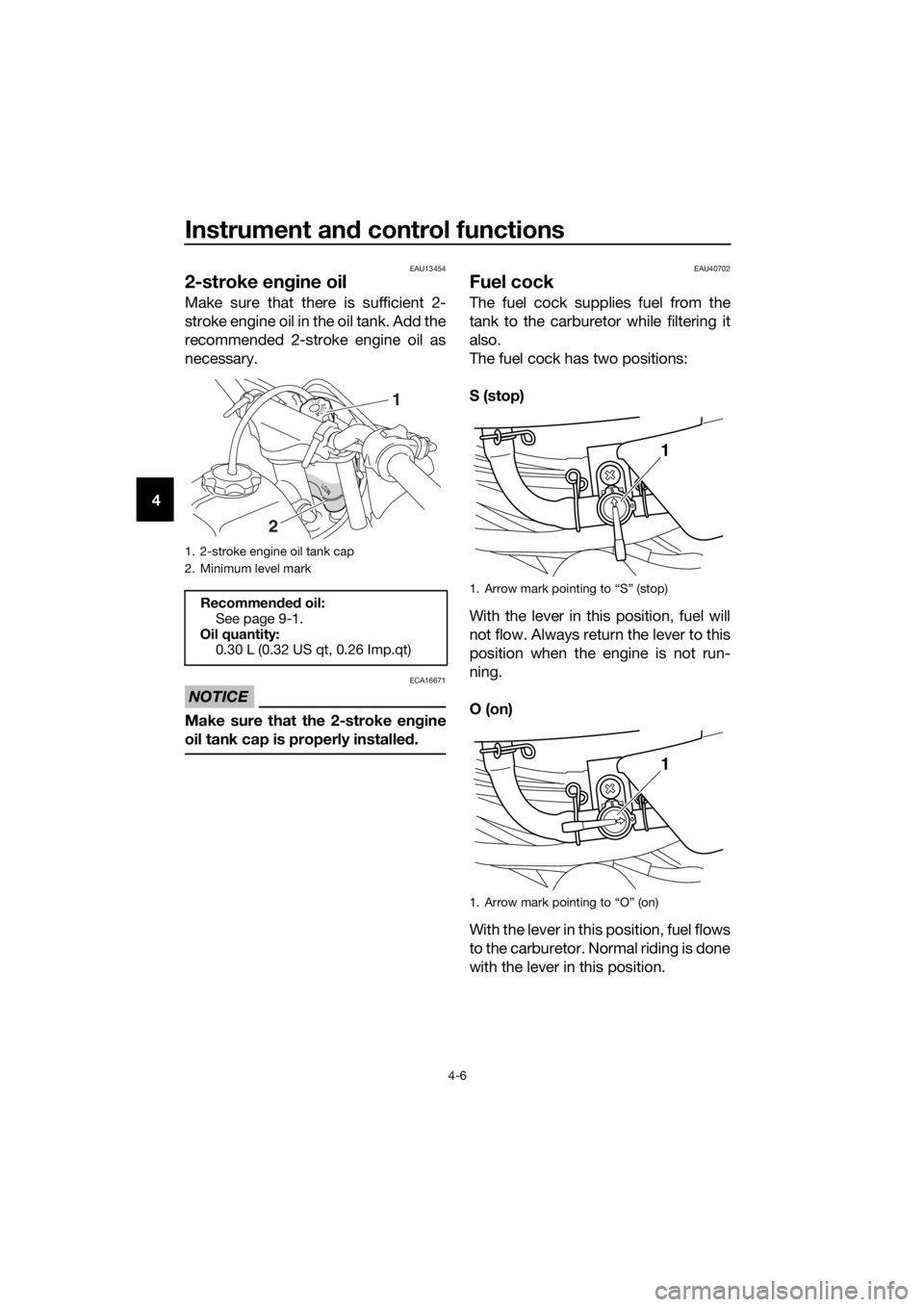
Instrument and control functions
4-6
4
EAU13454
2-stroke en gine oil
Make sure that there is sufficient 2-
stroke engine oil in the oil tank. Add the
recommended 2-stroke engine oil as
necessary.
NOTICE
ECA16671
Make sure that the 2-stroke en gine
oil tank cap is properly installe d.
EAU40702
Fuel cock
The fuel cock supplies fuel from the
tank to the carburetor while filtering it
also.
The fuel cock has two positions:
S (stop)
With the lever in this position, fuel will
not flow. Always return the lever to this
position when the engine is not run-
ning.
O (on)
With the lever in this position, fuel flows
to the carburetor. Normal riding is done
with the lever in this position.
1. 2-stroke engine oil tank cap
2. Minimum level mark
Recommen ded oil:
See page 9-1.
Oil quantity: 0.30 L (0.32 US qt, 0.26 Imp.qt)
2 1
1.
1.
1
1
U2SA88E0.book Page 6 Tuesday, May 11, 2021 3:44 PM
Page 33 of 82
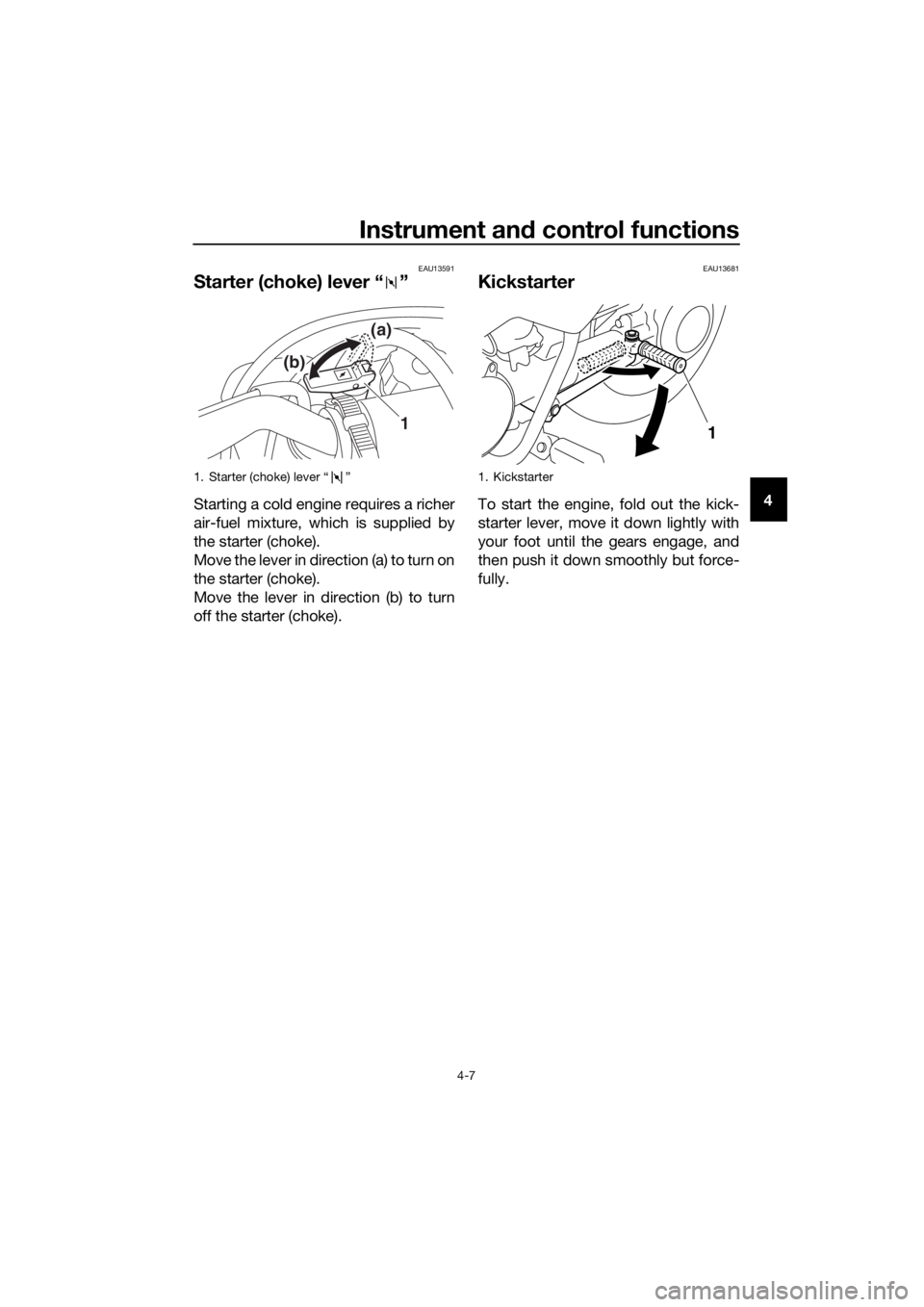
Instrument and control functions
4-7
4
EAU13591
Starter (choke) lever “ ”
Starting a cold engine requires a richer
air-fuel mixture, which is supplied by
the starter (choke).
Move the lever in direction (a) to turn on
the starter (choke).
Move the lever in direction (b) to turn
off the starter (choke).
EAU13681
Kickstarter
To start the engine, fold out the kick-
starter lever, move it down lightly with
your foot until the gears engage, and
then push it down smoothly but force-
fully.
1. Starter (choke) lever “ ”
1
(a)
(b)
1. Kickstarter
1
U2SA88E0.book Page 7 Tuesday, May 11, 2021 3:44 PM
Page 36 of 82
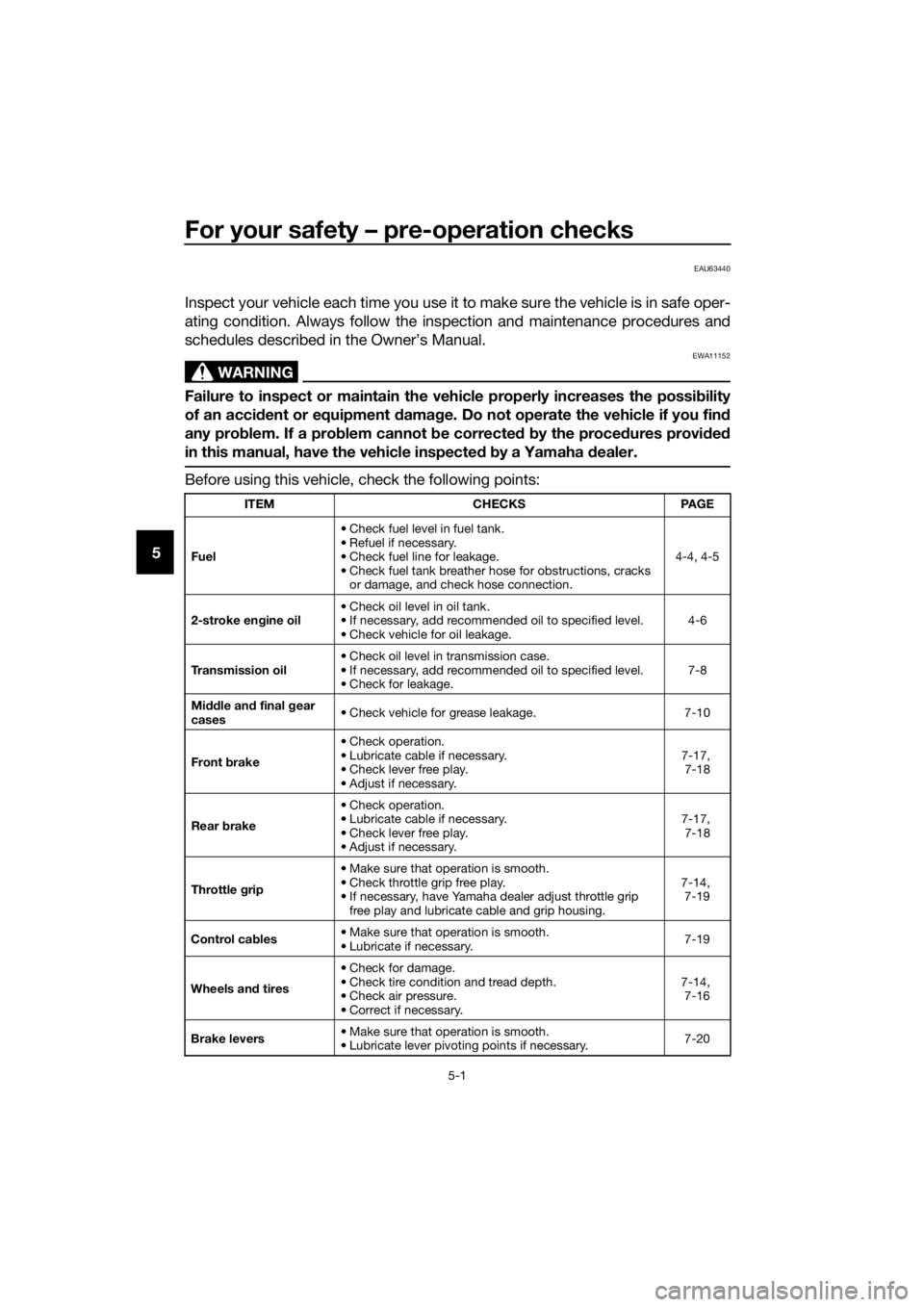
For your safety – pre-operation checks
5-1
5
EAU63440
Inspect your vehicle each time you use it to make sure the vehicle is in safe oper-
ating condition. Always follow the inspection and maintenance procedures and
schedules described in the Owner’s Manual.
WARNING
EWA11152
Failure to inspect or maintain the vehicle properly increases the possibility
of an acci dent or equipment d amage. Do not operate the vehicle if you fin d
any pro blem. If a pro blem cannot be correcte d b y the proce dures provi ded
in this manual, have the vehicle inspecte d b y a Yamaha dealer.
Before using this vehicle, check the following points:
ITEM CHECKSPAGE
Fuel • Check fuel level in fuel tank.
• Refuel if necessary.
• Check fuel line for leakage.
• Check fuel tank breather hose for obstructions, cracks
or damage, and check hose connection. 4-4, 4-5
2-stroke en gine oil • Check oil level in oil tank.
• If necessary, add recommended oil to specified level.
• Check vehicle for oil leakage. 4-6
Transmission oil • Check oil level in transmission case.
• If necessary, add recommended oil to specified level.
• Check for leakage. 7-8
Mi dd le an d final g ear
cases • Check vehicle for grease leakage.
7-10
Front brake • Check operation.
• Lubricate cable if necessary.
• Check lever free play.
• Adjust if necessary. 7-17,
7-18
Rear brake • Check operation.
• Lubricate cable if necessary.
• Check lever free play.
• Adjust if necessary. 7-17,
7-18
Throttle grip • Make sure that operation is smooth.
• Check throttle grip free play.
• If necessary, have Yamaha dealer adjust throttle grip
free play and lubricate cable and grip housing. 7-14,
7-19
Control ca bles • Make sure that operation is smooth.
• Lubricate if necessary.
7-19
Wheels an d tires •Check for damage.
• Check tire condition and tread depth.
• Check air pressure.
• Correct if necessary. 7-14,
7-16
Brake levers • Make sure that operation is smooth.
• Lubricate lever pivoting points if necessary.
7-20
U2SA88E0.book Page 1 Tuesday, May 11, 2021 3:44 PM